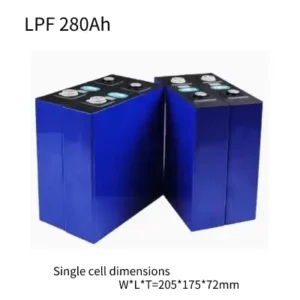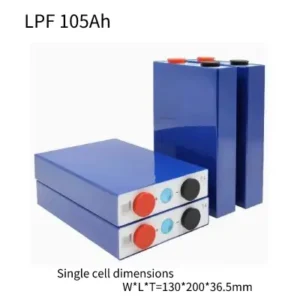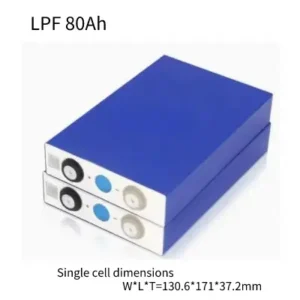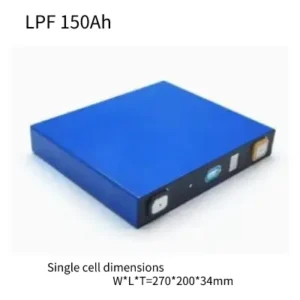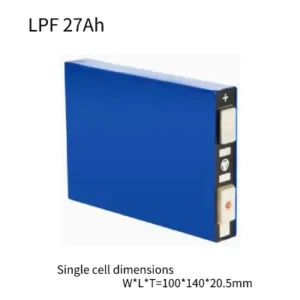3.2 V/3.65 V LiFePO4 Battery
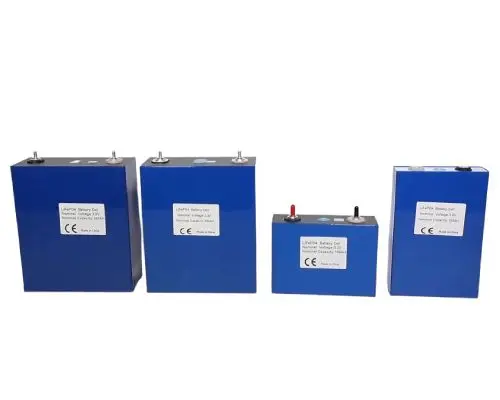
The 3.2V LiFePO4 cell is renowned for its high safety, long cycle life, and stable voltage platform. Compared with traditional lithium batteries, it offers superior thermal stability and excellent resistance to high temperatures and overcharging. Individual cells can be connected in series or parallel to form battery packs with different voltages and capacities, making them widely used in energy storage systems, electric vehicles, solar power applications, and backup power supplies.
iRay LiFePO4 Lithium Prismatic Iron Battery Model List
Here are the detailed specifications of our mass-produced lithium polymer batteries. If you have any questions, please feel free to contact us.
| Brand | Rated voltage (V) | Rated capacity (Ah) | Internal Impedance (mΩ) | Dimension (L*T*W mm) | Weight (kg) | Energy density (Wh/kg) | Shell Material | Terminal | Standard charge current | Maximum charge current | Standard discharge current | Maximum continuous discharge current | Discharging temperature range (℃) | |
|---|---|---|---|---|---|---|---|---|---|---|---|---|---|---|
| REPT | 3.2 | 50 | ≤0.7 | 148.4*39.72*95.77 | 1.18 | 136 | Aluminium | Laser | 0.5C | 1C | 0.5C | 1C | -20~55℃ | |
| REPT | 3.2 | 100 | ≤0.5 | 174.7*27.22*207.01 | 2.13 | 150 | Aluminium | Laser | 0.3C | 1C | 0.3C | 1C | -20~55℃ | |
| EVE | 3.2 | 50 | ≤0.7 | 135.3*29.3*185.3 | 1.395 | 115 | Aluminium | BOTH | 1C | 3C | 1C | 3C | -20~55℃ | |
| EVE | 3.2 | 105 | ≤0.5 | 130.3*36.7*200.3 | 1.98 | 119 | Aluminium | BOTH | 0.5C | 1C | 0.5C | 1C | -20~55℃ | |
| EVE | 3.2 | 230 | ≤0.3 | 173.93*53.85*207.3 | 4.11 | 179 | Aluminium | Laser | 0.5C | 1C | 0.5C | 1C | -30~60℃ | |
| EVE | 3.2 | 280 | ≤0.25 | 173.6*72*204.8 | 5.22 | 172 | Aluminium | Screw&Bolt | 0.5C | 1C | 0.5C | 1C | -20~55℃ | |
| CALB | 3.65 | 50 | 0.6~0.8 | 148.3*26.7*98 | 0.9 | 203 | Aluminium | Laser | 0.3C | 1C | 1C | 3C | -20~55℃ | |
| CALB | 3.2 | 72 | 0.1~0.5 | 135*30*220.8 | 1.78 | 129 | Aluminium | Screw&Bolt | 0.3C | 1C | 1C | 1C | -30~55℃ | |
| CALB | 3.2 | 100 | 0.2~0.5 | 160*49.9*18.5 | 2 | 160 | Aluminium | Laser | 0.4C | 1C | 1C | 1C | -20~60℃ | |
| CALB | 3.2 | 163 | 0.2~0.5 | 173*36.4*220 | 3.19 | 164 | Aluminium | Laser | 0.6C | 1C | 1C | 1C | -30~60℃ | |
| CALB | 3.2 | 230 | 0.1~0.5 | 173.93*53.72*207.2 | 4.17 | 176 | Aluminium | Laser | 0.25C | 1C | 1C | 0.5C | -30~60℃ | |
| CATL | 3.2 | 100 | 0.36±0.05 | 172.2*33.22*200.3 | 2.27 | 141 | Aluminium | Laser | 0.5C | 1C | 0.5C | 1C | -30~60℃ | |
| CATL | 3.2 | 125 | 0.36±0.05 | 172.2*33.4*200.3 | 2.43 | 165 | Aluminium | Aluminium | 0.5C | 1C | 0.5C | 1C | -30~60℃ | |
| CATL | 3.2 | 280 | 0.17±0.05 | 173.9*71.7*207.2 | 5.34 | 168 | Aluminium | Laser | 0.25C | 0.5C | 0.25 | 0.5C | -30~60℃ | |
| Lishen | 3.2 | 40 | ≤0.8 | 148*26.8*132.6 | 1.07 | 120 | Aluminium | Laser | 0.5C | 1C | 0.5C | 2C | -20~60℃ | |
| Lishen | 3.65 | 51 | ≤1.0 | 148*26.5*101.1 | 0.93 | 200 | Aluminium | Laser | 0.5C | 2C | 0.5C | 3C | -20~60℃ | |
| Gotion | 3.2 | 52 | 0.5~0.8 | 148*28*115 | 0.97 | 172 | Aluminium | Laser | 0.5C | 1C | 1C | 2C | -20~60℃ | |
| Gotion | 3.2 | 105 | 0.4~0.7 | 175*27*200 | 2.06 | 163 | Aluminium | Laser | 1C | 2C | 1C | 2C | -30~60℃ | |
| Ganfeng | 3.2 | 50 | ≤0.6 | 148.4*39.8*101.8 | 1.2 | 133 | Aluminium | Laser | 0.5C | 1C | 0.5C | 1C | -30~60℃ | |
| Ganfeng | 3.2 | 86 | ≤0.4 | 173.9*49*127.6 | 2.22 | 124 | Aluminium | Laser | 0.5C | 1C | 0.5C | 1C | -20~60℃ | |
| Ganfeng | 3.2 | 100 | ≤0.4 | 173.9*48*127.6 | 2.3 | 139 | Aluminium | Laser | 1C | 2C | 1C | 2C | -30~60℃ |
FAQs
What is the typical capacity range of a 3.2V LiFePO4 single cell?
The typical capacity ranges from 10Ah to 300Ah, depending on the cell size and design. Irayenergy can provide a full range of products from small to large capacities according to different applications.
What is the difference between the nominal voltage and actual operating voltage of a 3.2V LiFePO4 battery?
The nominal voltage is 3.2V, but the actual operating voltage ranges from 2.5V to 3.65V. 3.2V represents an average stable voltage platform.
Why is 3.2V the standard voltage for LiFePO4 cells?
Because the lithium iron phosphate chemistry provides the best balance of energy density and safety at this voltage.
Can a 3.2V LiFePO4 battery be used individually?
Generally, it is not used individually but combined in series or parallel to form higher voltage or capacity battery packs. However, a single cell can be used directly in some portable or low-voltage applications.
What are the advantages of 3.2V LiFePO4 batteries in energy storage systems?
It provides stable discharge voltage and a cycle life of over 4000 cycles, making it ideal for solar energy storage, home storage cabinets, and other applications that require long life and high safety.
What is the energy density of a 3.2V LiFePO4 battery?
The energy density is typically around 90–160 Wh/kg. Although slightly lower than ternary lithium batteries, LiFePO4 cells are superior in stability and resistance to thermal runaway.
Are 3.2V LiFePO4 batteries larger and heavier than ternary lithium batteries of the same capacity?
Yes, the energy density of LiFePO4 is slightly lower, so the volume and weight are slightly larger for the same capacity.
What charge and discharge currents can a 3.2V LiFePO4 cell support?
Typically, it supports a 1C continuous charge/discharge rate, while some models can handle 3C or higher, depending on the cell design and customer requirements.
Can Irayenergy provide 3.2V cells in different sizes?
Yes. Irayenergy can provide various sizes from small portable cells to large-capacity storage cells and supports custom designs.

